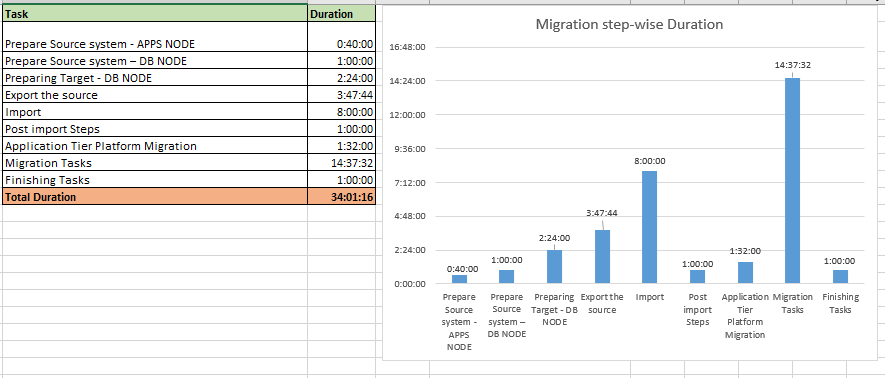Oracle EBS migration involves migration of Oracle Enterprise edition database with additional products that come under E-business suite.
Summarizing this migration, I would be highlighting some key notes on how this complete activity was planned.
Initially we only had brief information about migration and in such a scenario, it is very important to gather further information.
Below table was first step before deciding on migration approach -
Information Gathering & Backup
|
||
Task No
|
Task Name
|
Task Details
|
1
|
Backup Plan
|
RMAN script -
export v_rman_loc=/erp_backup/hotbkp rman target / run { allocate channel backup_disk1 type disk format '/erp_backup/hotbkp/%U'; allocate channel backup_disk2 type disk format '/erp_backup/hotbkp/%U'; allocate channel backup_disk3 type disk format '/erp_backup/hotbkp/%U'; allocate channel backup_disk4 type disk format '/erp_backup/hotbkp/%U'; backup as compressed backupset incremental level 0 cumulative database format '/erp_backup/hotbkp/full_backup_%d_%I_set%s_piece%p_copy%c_%T_%U' TAG=ERPDEV_FULL_BKP plus archivelog; release channel backup_disk1; release channel backup_disk2; release channel backup_disk3; release channel backup_disk4; } Apps tier script - /u01/appltst/app_tier_bkp.sh |
4
|
EBS latest RPC patch details
|
select BUG_ID,BUG_NUMBER,TRACKABLE_ENTITY_ABBR,CREATION_DATE
from ad_bugs where
bug_number in ( '17774755', --rpc1 '19030202', --rpc2 '20203366', --rpc3 '21236633', --rpc4 '22644544', --rpc5 '29295435' --fndrpcfeb2019 ); |
5
|
Number of files for Data Files,DB Home,
apps tier
|
|
6
|
IOP Patches information
|
select
BUG_ID,BUG_NUMBER,TRACKABLE_ENTITY_ABBR,CREATION_DATE from ad_bugs where
bug_number in ( '7303030', --Patch 18843706 - apply only if you have applied a Recommended Patch Collection (RPC) patch '9062910', --11g Release 2 interoperability patch for Release 12.1 '8919489', --12.1 TXK Delta 3 patch '9868229', '10163753', '11071569', '18843706' --apply only if you have applied a Recommended Patch Collection (RPC) patch ); |
7
|
pre-requisite patches on RDBMS HOME
|
opatch lsinv | grep <Patch number>
|
8
|
Check for export/import Patch
16541956
|
select
BUG_ID,BUG_NUMBER,TRACKABLE_ENTITY_ABBR,CREATION_DATE from ad_bugs where
bug_number in
( '16541956' –expdp_impdp_patch_11g ); |
9
|
NFS availability to speed up
export-import
|
|
10
|
Database Vault ?
|
SELECT parameter, value
FROM V$OPTION WHERE PARAMETER = 'Oracle Database Vault'; |
11
|
recycle bin objects
|
select * from DBA_RECYCLEBIN;
|
12
|
DB Size
|
select sum(bytes / (1024*1024*1024)) "DB
Size in GB" from dba_data_files;
####Oracle_DB||How large is the database||##### col "Database Size" format a20 col "Free space" format a20 col "Used space" format a20 select round(sum(used.bytes) / 1024 / 1024 / 1024 ) || ' GB' "Database Size" , round(sum(used.bytes) / 1024 / 1024 / 1024 ) - round(free.p / 1024 / 1024 / 1024) || ' GB' "Used space" , round(free.p / 1024 / 1024 / 1024) || ' GB' "Free space" from (select bytes from v$datafile union all select bytes from v$tempfile union all select bytes from v$log) used , (select sum(bytes) as p from dba_free_space) free group by free.p / |
13
|
List of modules implemented
|
SELECT fav.application_id,
fav.application_short_name, fav.application_name, fav.basepath, fav.creation_date, fpi.status, fpi.patch_level, fpi.product_version, fpi.TABLESPACE, fpi.index_tablespace, fpi.temporary_tablespace FROM fnd_application_vl fav, fnd_product_installations fpi WHERE fav.application_id = fpi.application_id(+) ORDER BY creation_date DESC |
14
|
10.1.3 IAS_HOME version check
|
$IAS_ORACLE_HOME/Apache/Apache/bin/httpd -v
|
15
|
10.1.2 OH version check
|
$ORACLE_HOME/bin/frmcmp_batch|grep Forms| grep
Version
|
16
|
JDK Version check
|
cat $FORMS_WEB_CONFIG_FILE|grep
sun_plugin_version| cut -c 1-35
|
Next phase was understanding migration approaches available for migrating an EBS environment and which approach will be most feasible
one.
Below are methods that can be followed, and they can vary from customer to customer depending upon affordability, environment, customer infrastructure
configurations and setups-
When we narrow down migration approach, below are key factors that must be taken into consideration.
1. Source and Destination Platform
2. DB size
3. Migration approach supported for EBS?
4. Downtime acceptance by Customer
5. Integration with Oracle EBS
In my case, below were migration key factors -
1. Linux x86-64 to Solaris SPARC 642. 80gb
3. Oracle EBS r12.1.3 with 11.2.0.4 database
4. Customer approved 24 hours of downtime during weekend followed by 24 hours for testing.
5. TAMS was integrated with Oracle.
Client had two ERP environments (ERP-PROD, ERP-DEV).
This project involved migration database and applications tier from Linux x86_64 (single node) to Solaris SPARC 64-bit (multi-node).
Migration approach chosen in above scenario was Export/import process for following reasons-
1. Db size was less than 1Tb.2. Not as complicated as Transportable Tablespace.
3. Is transparent to endianness of Source and destination.
Below are reference notes from metalink for Cross-platform migration -
• Export/import process for 12.0 or 12.1 using 11gR1 or 11gR2 (Doc ID 741818.1)- This document will be primarily used for database migration.
• Application Tier Platform Migration with Oracle E-Business Suite Release 12 (Doc ID 438086.1)
- Apps tier will be migrated referring above document.
• Using AutoConfig to Manage System Configurations in Oracle E-Business Suite Release 12 (Doc ID 387859.1)
- We will be using this document to generate context file and executing autoconfig successfully.
• Upgrading to the Latest OracleAS 10g 10.1.3.x Patch Set in Oracle E-Business Suite Release 12 (Doc ID 454811.1)
- Referred for IAS_HOME upgrade
• R12.1.1 : Oracle E-Business Suite Installation and Upgrade Notes Release 12 (12.1.1) for Oracle Solaris on SPARC (64-bit) - Doc ID 761568.1
After ERP-DEV migration, we evaluated duration for every single activity with duration as follows -
Conclusion -
This blog only covered few guidelines on evaluating migration approach and justifying it before finally migrating production environment.This approach will ease your strategy and decision making on migration plan as there are so many migration options available for migrating and Oracle database but they differ from environment to environment and further narrow down for EBS environments.



Nice one
ReplyDelete